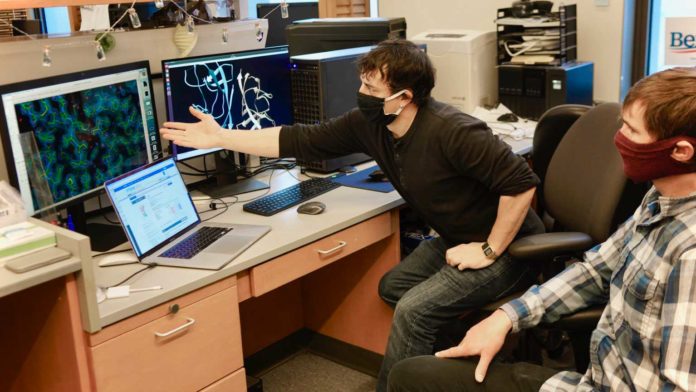The molecular basis for the severity and rapid spread of the COVID-19 disease caused by SARS-CoV-2 is mostly unknown.
To do so, a team of HIV researchers, cellular biologists, and biophysicists collaborated to determine the atomic structure of a coronavirus protein. The protein is thought to the pathogen to evade and dampen response from human immune cells.
The accessory protein ORF8 is one of the most rapidly evolving betacoronavirus proteins that have been proposed to interfere with immune responses.
For this study, scientists used X-ray crystallography to build an atomic model of ORF8. The model highlighted two unique regions: one that is only present in SARS-CoV-2 and its immediate bat ancestor, and one that is absent from any other coronavirus.
Lead author James Hurley, a UC Berkeley professor and former faculty scientist at Lawrence Berkeley National Laboratory (Berkeley Lab), said, “These regions stabilize the protein – which is a secreted protein, not bound to the membrane-like the virus’s characteristic spike proteins – and create new intermolecular interfaces. We, and others in the research community, believe these interfaces are involved in reactions that somehow make SARS-CoV-2 more pathogenic than the strains it evolved from.”
Generating protein structure maps is a hectic task; scientists need to engineer bacteria that can pump out large quantities of the molecule, manipulate the molecules into a pure crystalline form, and then take many X-ray diffraction images of the crystals. These images – produced as X-ray beams bounce off atoms in the crystals and pass through gaps in the lattice, generating a pattern of spots – are combined and analyzed via special software to determine every individual’s location atom. This painstaking process can take years, depending on the complexity of the protein.
For some proteins, the way toward building a guide is helped by comparing the unsolved molecule’s structure with different proteins with comparative amino acid sequences that have just been planned, allowing scientists to make informed guesses about how the protein folds into its 3D shape.
But for ORF8, the team had to start from scratch. ORF8’s amino acid sequence is so unlike any other protein that scientists had no reference for its overall shape, and it is the 3D shape of a protein that determines its function.
Marc Allaire, a biophysicist and crystallography expert at the Berkeley Center for Structural Biology, located at Berkeley Lab’s Advanced Light Source (ALS), said, “Coronaviruses mutate differently than viruses like influenza or HIV, which quickly accumulate many little changes through a process called hypermutation. In coronaviruses, big chunks of nucleic acids sometimes move around through recombination. When this happens, big, new regions of proteins can appear.”
“Genetic analyses conducted very early in the SARS-CoV-2 pandemic revealed that this new strain had evolved from a coronavirus that infects bats. A significant recombination mutation occurred in the genome area that codes for a protein, called ORF7, found in many coronaviruses. The new form of ORF7, named ORF8, quickly gained the attention of virologists and epidemiologists because significant genetic divergence events like the one seen for ORF8 are often the cause of a new strain’s virulence.”
“This mutation caused the protein to double in size, and the stuff that doubled was not related to any known fold. There’s a core of about half of it that’s related to a known fold type in a solved structure from earlier coronaviruses, but the other half was completely new.”
Scientists are willing to share their results begin impactful follow-up studies months earlier than the traditional publication process would have allowed.
Allaire explained, “the all-hands-on-deck crisis caused by the pandemic shifted everyone in the research community into a pragmatic mindset. Rather than worrying about who accomplished something first, or sticking to the confines of their specific areas of study, scientists shared data early and often, and took on new projects when they had the resources and expertise needed.”
“When we started this, other projects had been put on hold, and we had this unique opportunity to hunker down and solve an urgent problem. We worked very closely, with a lot of back and forth until we got it right. It has been one of the best collaborations of my career.”
Journal Reference:
- Thomas G. Flower et al. Structure of SARS-CoV-2 ORF8, a rapidly evolving immune evasion protein. DOI: 10.1073/pnas.2021785118
